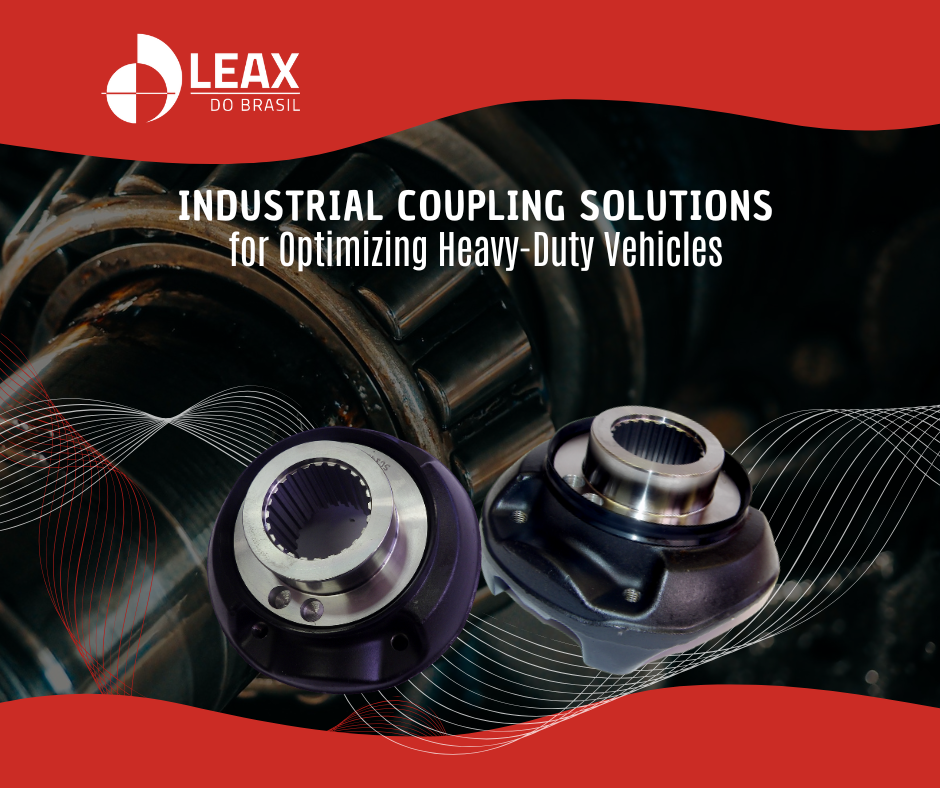In the realm of heavy-duty vehicles, such as cargo trucks, articulated buses, and mining equipment, industrial couplings play a critical role in ensuring efficient power transmission. These components connect rotating shafts, compensate for misalignments, absorb vibrations, and protect systems from overloads, delivering durability and performance under demanding conditions. For engineers, fleet owners, and truck manufacturers, understanding the available coupling solutions and their applications is essential to optimize operations, reduce maintenance costs, and meet market demands. This article explores the key industrial coupling solutions, their technical characteristics, and their applications in addressing the specific challenges of heavy-duty vehicles.
The Role of Couplings in Heavy-Duty Vehicles
Industrial couplings are designed to transmit torque and rotation between the driving shaft (connected to the engine) and the driven shaft (such as the transmission or differential) in mechanical systems. In trucks, for instance, they link the engine to the gearbox or cardan shaft, ensuring synchronization and efficiency. Additionally, couplings compensate for axial, radial, or angular misalignments caused by vibrations, dynamic loads, or natural wear. For heavy-duty vehicles operating under high loads and in harsh environments, selecting the right coupling directly impacts reliability, safety, and operational costs.
The challenges faced by engineers and fleet managers include choosing couplings that withstand high torques, endure extreme conditions (such as dust, moisture, or high temperatures), and minimize unplanned downtime. Below, we detail the most relevant coupling categories for heavy-duty vehicles, focusing on their applications and benefits.
1. Rigid Couplings: Precision for Aligned Systems
Rigid couplings are widely used in heavy-duty vehicle systems where shaft alignment is near-perfect. Made from materials like carbon steel or high-strength alloys, these couplings provide torque transmission without backlash, making them ideal for components like differentials or transfer cases in tipper trucks. Their robustness supports heavy loads, common in vehicles for mining or construction transport.
However, their lack of flexibility makes rigid couplings sensitive to misalignments. For manufacturers, this demands precision in design and assembly, while fleet owners must prioritize regular alignment checks during maintenance. A practical example is their use in rigid-chassis trucks, where system stability ensures longevity, provided installation conditions are optimal.
2. Elastic Flexible Couplings: Vibration Absorption
Elastic flexible couplings are essential for heavy-duty vehicles subject to vibrations and shocks, such as off-road trucks or agricultural tractors. Comprising elastic elements like rubber or polyurethane, these couplings absorb the impact of sudden starts and compensate for moderate misalignments. In cargo trucks, they are often used to connect engines to hydraulic pumps or auxiliary systems, reducing wear on gears and bearings.
For engineers, the advantage lies in customization: elastic elements can be tailored to specific torque and rotation levels. Fleet owners benefit from low maintenance and extended component lifespan. An example is their use in concrete mixer trucks, where elastic couplings minimize vibrations during drum rotation.
3. Gear Couplings: High-Torque Resilience
Designed for high-torque applications, gear couplings are ideal for heavy-duty vehicles operating in extreme conditions, such as mining trucks or mobile cranes. These couplings consist of hubs with meshed teeth, transmitting power even with moderate misalignments. Their robust construction handles heavy loads, while proper lubrication ensures durability.
Manufacturers value gear couplings for their reliability in complex transmission systems, such as those in articulated trucks. For fleet managers, regular maintenance (e.g., lubricant checks) is critical to prevent premature wear. A practical case is their use in off-road trucks, where gear couplings handle intense torques during heavy load transport on uneven terrain.
4. Disc Couplings: High-Speed Precision
Disc couplings, or flexible disc couplings, are perfect for heavy-duty vehicles operating at high speeds, such as long-haul buses or highway transport trucks. Composed of stacked metal discs, these couplings transmit torque with high precision, without backlash, and compensate for angular and axial misalignments. Their lightweight, balanced design reduces vibrations, crucial for sensitive transmission systems.
Engineers appreciate their ability to operate at high speeds, while manufacturers integrate them into designs requiring energy efficiency. For fleets, durability and low maintenance are key benefits. An example is their use in highway buses, where disc couplings ensure smooth transmission, enhancing passenger comfort.
5. Hydraulic Couplings: Smooth Torque Control
Hydraulic couplings are ideal for heavy-duty vehicles requiring smooth starts and overload protection, such as cranes or trucks with heavy auxiliary systems. Using fluids to transmit power, these couplings enable gradual torque control, reducing stress on critical components. They are commonly applied in hydraulic systems of specialized trucks, such as those for transporting fragile cargo.
For manufacturers, hydraulic couplings facilitate the design of multifunctional vehicles, while fleet owners value their protection against mechanical failures. Maintenance involves checking fluid levels and seals, but their robustness justifies the investment. An example is their use in fire trucks, where hydraulic couplings ensure smooth operation of high-pressure pumps.
Selection and Maintenance Considerations
Choosing the right coupling for heavy-duty vehicles depends on factors such as torque, speed, misalignment type, environmental conditions, and technical standards (e.g., ISO 7646). Engineers must consider vehicle specifications, while manufacturers align couplings with production and performance standards. Fleet owners should invest in preventive maintenance, including lubrication, wear inspections, and alignment, to avoid costly downtime.
Leax do Brasil, for instance, offers tailored solutions for heavy-duty vehicles, with couplings designed for high durability and efficiency. Consulting trusted suppliers and specialists is key to ensuring compatibility and maximizing return on investment.
Industrial couplings are the backbone of power transmission in heavy-duty vehicles, directly impacting efficiency, safety, and operational costs. From rigid couplings offering precision to hydraulic couplings ensuring smoothness, each solution addresses specific demands of trucks, buses, and heavy equipment. For engineers, fleet owners, and manufacturers, careful coupling selection, paired with strategic maintenance, is a competitive advantage. Companies like Leax do Brasil provide the expertise needed to transform these components into productivity allies.
Explore industrial coupling solutions and optimize your fleet or production line.
Conheça também outras matérias de nosso Blog:
Desvendando o Eixo Cardan da Leax
Sistema de Transmissão: O Segredo do Movimento e a Excelência das Peças de Precisão
LEAX do Brasil Obtém Certificado Internacional de Energia Renovável (I-REC): Um Passo Significativo na Jornada de Descarbonização
Dúvidas? Entre em Contato:
[email protected]








Leave A Comment